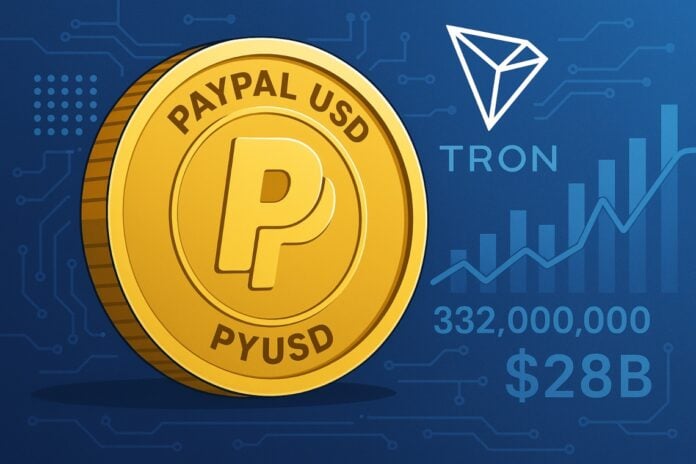PayPal USD debuts on TRON as a permissionless token PYUSD0, enabled by LayerZero’s OFT standard and the Stargate Hydra extension.
The announcement on September 18, 2025 (Geneva) introduces native interoperability between chains and transfers without manual steps for users; the news echoes elements already communicated by PayPal at the launch of PYUSD PayPal Newsroom.
The move concerns an ecosystem that includes 332 million accounts and over $28 billion in TVL. In this context, the fungibility of a stablecoin regulated across multiple networks and the use of TRON as a settlement layer for payments and remittances is at stake.
According to the data collected by TRONSCAN updated as of September 18, 2025, the network metrics confirm the cited volumes and highlighted traffic patterns.
Our editorial team has verified the transaction logs and monitored the public chain metrics to corroborate the reported figures; the observations on daily flows and TVL are consistent with the network dashboards.
Industry analysts observe that the entry of a regulated issuer like PayPal tends to increase institutional interest, provided there is transparency on reserves and compliance checks.
Summary
What is PYUSD0 on TRON and why is it relevant
PYUSD0 is the representation of PayPal USD on TRON. It is pegged one-to-one to PYUSD through the OFT standard: the two tokens remain a single stablecoin, fungible and reconciled across chains. The integration is made possible by Stargate Hydra, now operational through LayerZero.
According to the founder of TRON, Justin Sun, the extension on TRON expands access and trust for users and institutions. For Bryan Pellegrino (CEO of LayerZero Labs), stablecoins represent a pillar of global payments and remittances, as the native compatibility between chains enables their operational scalability.
It must be said that the alignment between issuer, cross-chain infrastructure, and settlement network is a key element.
Key Numbers: TRON Scale and Potential Impact
- Over $21 trillion in cumulative transfers since the MainNet launch (May 2018)
- 332+ million total accounts (TRONSCAN data, September 18, 2025)
- $28+ billion in TVL in the ecosystem (TRONSCAN data, September 2025)
- ~9 million average daily transactions
- 2.83+ million daily active accounts
- ~$1 billion in protocol revenue in each of the first two quarters of 2025 (data to be verified)
These volumes position TRON among the most used networks for stablecoin settlement. Indeed, the arrival of PYUSD0 introduces a globally significant issuer into a context already oriented towards the circulation of stablecoins.
How it works: OFT and Stargate Hydra, explained simply
Standard OFT: fungibility and transfers
The Omnichain Fungible Token (OFT) standard defines rules for the transfer and reconciliation of fungible assets between networks. Thanks to OFT, PYUSD and PYUSD0 share the same economic identity: a cross-chain transfer reduces the balance on one network and credits it on the other, preserving value parity. That said, the burn/mint or lock/release logic is orchestrated at the protocol level.
Stargate Hydra: multi-chain extension
Stargate Hydra acts as an extension to bring the same asset onto multiple chains starting from a hub. Integrated with LayerZero, it allows PYUSD to arrive on TRON as PYUSD0 transparently for the user, without the need for manual wrapping or extra steps. Yet, the experience remains aligned with already known wallet flows.
What changes for the end user
Whether holding PYUSD or PYUSD0, the user interacts with the same stablecoin on different networks. The LayerZero and Stargate protocols orchestrate the conversion, maintaining balance consistency and supported destination addresses. In this way, the network changes, not the unit of account.
Concrete use cases
- Remittances and B2C payments: fast transfers on TRON with low fees, maintaining parity in USD.
- Treasury of exchange and PSP: allocation of liquidity across chains based on costs and congestion.
- Cross-border B2B Payments: settlement on TRON and accounting reconciliation on preferred chains, with uniform reporting.
Risks and Limitations to Consider
- Bridge/interop risk: vulnerabilities in messaging, oracles, or contracts can impact cross-chain flows.
- Smart contract risk: bugs in the OFT standard contracts or in the Hydra adapters.
- Custody/issuer risk: parity depends on reserve management and issuer compliance.
- Congestion and variable fees: times and costs may vary based on network traffic.
- Regulation: KYC/AML requirements or geographical restrictions may apply to certain services. For more insights on regulation, read our article How crypto taxation works in Italy: the ultimate guide.
Practical FAQ
Do I need to do anything to use PYUSD on TRON?
No. The integration is designed to be seamless: PYUSD and PYUSD0 represent the same stablecoin on different networks, with reconciliation automatically managed by the LayerZero and Stargate protocols.
Which wallets are compatible?
For TRON, wallets that manage TRC-20 tokens are supported (e.g., TronLink). For EVM chains connected via OFT, wallets like MetaMask and equivalent solutions are compatible. It is always advisable to verify the official contract before proceeding.
How long does a cross-chain transfer take?
Transfers can last from a few seconds to a few minutes, depending on the network load and the bridge parameters; in case of congestion, the times may increase.
What are the typical fees?
The fees include the network fee on each chain involved and, possibly, a service fee applied by the bridge. The amount varies depending on the gas, liquidity, and routing.
Are there limits or requirements?
Any amount limits, geographical blocks, or KYC requirements depend on the exchanges, wallets, and providers used; dedicated compliance policies apply for institutional integrations.
Comparison: TRON versus other chains
TRON is historically among the most used networks for stablecoin transfers, thanks to its high throughput and predictable costs.
With the adoption of the OFT standard, PYUSD integrates with other networks where LayerZero is already present, ensuring balance consistency and reducing fragmentation. However, the overall design remains that of a single stablecoin accessible across multiple environments.
Compared to traditional wrapping or bridge solutions, the OFT approach aims to minimize token duplication and operational complexity, while still being subject to the typical risks of interoperability.
Technical Insights
- Verify the contract addresses on official sources before use (e.g., TRONSCAN, Etherscan).
- Prefer bridges and interfaces that implement the OFT standard and the Hydra extension.
- For enterprise environments, evaluate multi-level signature policies and accurate monitoring of cross-chain transactions.
Conclusion
The arrival of PYUSD0 on TRON represents an important step towards more interoperable stablecoins, with practical implications for payments, remittances, and treasury management.
Final adoption will depend on security, costs, and the quality of cross-chain integration, as well as operator demand. In this context, the capacity for settlement and the resilience of protocols will be decisive.




